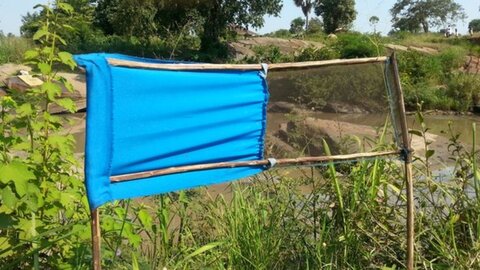Do I need to deploy the baits evenly?

Tsetse Plan will advise you to deploy say 1000 targets and treat 3000 cattle. The baits should be distributed as evenly as possible within the baited area. Some departure from this is allowable in the interests of convenience, but there are some general principles that you should follow.
Targets
Any targets should go in the areas where any treated cattle do not go. It is usually most convenient to put the targets in lines, with the targets occurring at intervals of 150-250m within the lines, and with the lines no more than 1 km apart for relatively immobile species (eg, G. austeni) and no more than 2km apart for highly mobile species (eg, G. pallidipes and G. longipennis). For other species the lines should be no more than 1.5km apart. Tiny targets deployed along water courses for riverine species (eg G. fuscipes and G. palpalis) should be deployed every 50 to 100 linear metres.
Insecticide-treated cattle
In some cases, you may be able to adjust the herding patterns of insecticide-treated cattle to increase the impact on tsetse.
To do this, the treated cattle should be herded to ensure maximum contact with the tsetse population, spending as much time as possible within the main tsetse concentration areas at times of day when the flies are active. Your survey data for the pretreatment data will allow you to identify the types of vegetation where the flies are plentiful.
For most savannah species, ie, G. pallidipes, G. morsitans, and G. swynnertoni, the most important vegetation types are usually savannah woodlands or the more open type of thickets, but G. longipennis is often found in scrubland. Thicket and riverine species, such as G. austeni, G. brevipalpis, G. fuscipes and G. palpalis are often found in denser vegetation with relatively little grazings so that it is not practicable to keep the cattle in such places for long, but it should be possible to graze them for longer periods immediately outside such vegetation.
At most seasons tsetse are active in the first few hours after sunrise and the last hour or so before sunset. In the cool season, the peak of activity occurs in the middle of the day. For G. fuscipes and G. palpalis, the middle of the day is often important at all seasons.
Herdsmen usually keep their cattle away from the main concentrations of tsetse, especially at times of maximum tsetse activity. So you will need to explain the advantages of changing this policy with treated cattle.
The strategy of intentionally grazing treated cattle in heavily infested areas will lead, in the short-term, to an increase in disease. This may not be acceptable to farmers, in which case make sure you deploy targets in these areas.
Survey traps
It is usually best to divide the monitoring and survey baits into two groups:
a) permanent sites or transects at "hot-spots", to give an overview of population changes during the whole operation, and;
b) temporary sites or transects used for studying from time to time what is happening elsewhere. About half to two-thirds of the sampling should be in hot-spots.
If the area is subject to invasion, ensure that about half of the permanent sampling is conducted in lines across the invasion front, from about 5-8km inside the invasion source to about the same distance inside the operational area.